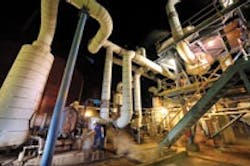About the author: TJ Meredith is a project manager for the Veolia Water North America Industrial Business Group. Meredith can be reached at [email protected].
A pigment manufacturing plant in the southern U.S. wanted to ensure that it could meet pending local wastewater discharge requirements. Money for capital upgrades was scarce, and valuable employee resources were being used to operate a treatment plant rather than focus on the company’s core business. The company turned to Veolia Water for a solution: a comprehensive design/build/operate industrial water reclamation facility upgrade at the plant.
Through a service partnership with Veolia, the plant obtained the additional equipment needed to meet the pending discharge regulations. It also gained a professional operating staff, freeing up personnel to focus on pigment manufacturing.
The Veolia-supplied equipment was started up in November 2000. The upgraded reclamation facility treats the plant’s wastewater to meet local discharge limits, and also allows the plant to reuse a portion of the processed wastewater in the manufacturing process. Because Veolia owns, operates and maintains the added water treatment equipment, there is no additional out-of-pocket expense to the client. In fact, the cost of these services is comparable to the client’s existing budget.
Original Treatment Plant
The client is one of the largest suppliers to the printing and packaging industry worldwide. A byproduct of its manufacturing process is salt in the form of calcium chloride. Because the company strives to continuously improve sustainability and reduce its environmental impact, it built a 0.55 million-gal-per-day (mgd) water reclamation facility to treat the brackish water produced by the pigments plant.
The facility uses microfiltration (MF) to pretreat the wastewater. This system incorporates cross-flow tubular membranes that remove precipitated contaminants and produce a high-quality filtrate suitable for discharge or further treatment.
MF system permeate water is fed to a reverse osmosis (RO) system for further treatment. The RO systems use a semi-permeable membrane at high pressure to remove dissolved salts from the water.
Value-Added Upgrade
As part of Veolia’s process upgrade and optimization solution, the company met with the client at its manufacturing plant to review and assess the water reclamation plant operations. It identified equipment that needed to be added for optimal process performance, and implemented a project plan that met the client’s goals and budget.
The resulting 20-year contract called for Veolia to finance, design, build, own, operate, maintain and manage services and upgrades to the water treatment process.
This included:
- An oxidizer to reduce soluble color;
- A repurposed 500,000-gal equalization tank;
- Additional water softener filtering aids and flocculants;
- A 100,000-gal clarifier; and
- A multi-stage mechanical vapor recompression evaporator and crystallizer system.
In addition to guaranteeing the treatment results, Veolia is responsible for chemicals, labor, maintenance and residuals, eliminating risk for the client, who retains ownership of all the existing water treatment equipment and its discharge permit.
Veolia offered employment and comparable wages and benefits to the client’s existing water operations staff, and supplemented the staff with technical specialists, including a chemist and full-time maintenance staff. The company also trained the existing operators on the new water treatment equipment.
Treatment Process
The pigments plant uses 300,000 gal per day (gpd) of water in the manufacturing process. The goal of the treatment process is to recycle a majority (80%) of the waste and minimize municipal water demand.
Wastewater (450,000 gpd) from the manufacturing process is pretreated in equalization tanks and then softened to remove hardness ions. Next, the water is sent to the MF system for metals and inorganics removal, then to the RO system, where 99% of the dissolved salts are removed.
The RO reject water (100,000 gpd) containing the briny waste is sent to the evaporator and crystallizer system, which concentrates the calcium chloride, producing 6 tons per day of dry salt crystals. The quality of the water recovered from the process is high enough to be reused as manufacturing process water.
The water softener discharge is sent to the clarifier, which concentrates the waste solids and produces 1 ton per day of sludge. The salt crystals and sludge are trucked to a landfill for disposal.
Plant Operating Results
The upgraded water reclamation plant is operating well and meeting local, state and federal wastewater discharge regulations. Eight full-time treatment experts share the responsibility for the 500,000-gpd, $12-million facility, which operates around the clock.
The results are impressive. Six to 8 tons per day of salt sludge are conditioned with ferric chloride, dewatered on a pressure filter and disposed of at a local landfill, keeping it out of the local watershed. Additionally, 200,000 gal of high-quality process water are recovered daily and reused in the manufacturing process, reducing potable water costs.
Veolia provided the client with a solution that defined the characteristics of a complex and varied industrial effluent stream, and also provided the knowledge base to implement proven water treatment technologies.
The motto on this project was, “reduce, reclaim, sustain” and the goal was to reduce the amount of inorganic salts in the waste stream and reclaim a significant portion of the wastewater as high-purity process water. Both efforts allow the client to sustain a healthy business in its currently water-scarce, centrally located heartland location.
Download: Here
